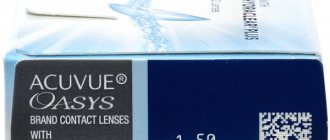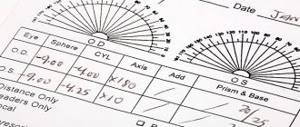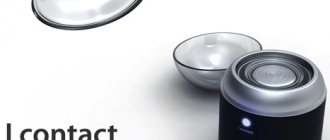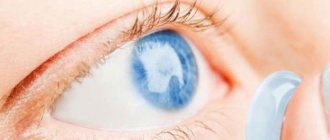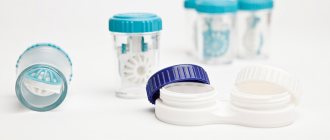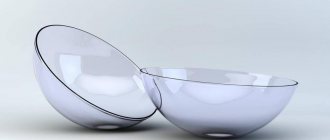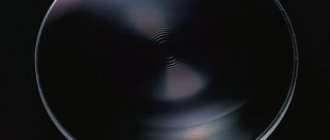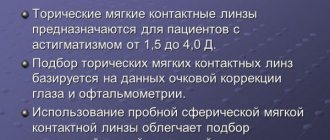Basic parameters of contact lenses (CL) for the correction of myopia and farsightedness
The most important are the first three indicators:
- Optical power (Sph) is an index of refraction. OS in the right eye may be different from the left. Expressed as positive (for farsightedness) or negative (for myopia) numbers in diopters (Dopters).
- The radius of base curvature (BC) indicates the radius of curvature of the cornea. Varies from 8.2 (more convex) to 9.0 (flatter).
- Diameter (DIA) is, in simple terms, the size of the CL surface. As a rule, it is the same in both eyes and varies from 13.0 mm to 15.0 mm.
- The material is what determines the basic properties of the KO. There are hydrogel and silicone hydrogel. Hydrogel SCLs are softer and thinner, but more susceptible to mechanical damage; silicone hydrogel models are usually thicker and stiffer, but they will be more difficult to tear, and some users claim that they are easier to put on than hydrogel ones.
- The thickness at the center depends on the lens material, its moisture content and the size of the optical zone. Typically, hypermetropia correctors are thicker in the center and thinner at the edges, while myopia correctors are the opposite.
- Moisture content shows the level of moisture content in the material. Through the hydrogel substance, oxygen is supplied to the cornea using water molecules. This means that the higher this indicator, the better the cornea will “breathe”.
- Oxygen permeability (Dk/t) is determined by the ratio of the volume of oxygen passed per unit time through a unit area of the lens. The surface of silicone hydrogel optics allows more air to pass through than the surface of hydrogel analogues. Due to their high level of oxygen permeability, some of them can be worn without taking them off for several weeks or even a month, for example, PureVision 2HD from Bausch & Lomb or Air Optix Night & Day.
- The replacement schedule shows how often you will need to wear a fresh pair of lenses. The schedule can be one-day, two-week, monthly, quarterly and traditional (it is possible to use KO for 6-12 months).
- Wearing mode is the period of time during which it will be possible not to remove the SCL without risk to health. There are five different wearing modes. Daytime: they are put on in the morning and placed in a container before going to bed. Night (orthokeratology): worn only while sleeping. Flexible: you can walk in such CLs for 1-2 days. Extended: means wearing for up to a week. Continuous: you can leave them on for a whole month.
Physical parameters of contact lenses
These include criteria such as design, moisture content, electrostatic properties, oxygen permeability. Let's try to understand this in more detail.
Moisture content is very easy to determine. To do this, you just need to calculate as a percentage the ratio of the weight of water in the contact lens to its total weight when saturated with moisture. It is known that the higher the hydrophilic indicators, the higher the sensitivity of the material to mechanical damage.
Biotrue ONE day contact lenses contain a record amount of moisture - 78%
As for the FDA , the US Federal Commission on Drugs and Dietary Supplements (which is what this abbreviation stands for) distinguishes four groups, selection into which is based on two indicators: water content and electrical properties. The first group includes products made from non-ionic polymer with low water content - Polimakon (38%), Senofilkon A (38%), Tetrafilkon A (43%), the second - with high water content - Hilafilkon A (70%), B (59 %), Omafilcon A (59%), Lidofilcon A (70%). The third group included products made from ionic polymers with low moisture content - Deltafilcon A (43%), Bufilcon (45%), Flemfilcon A (38%), and the fourth - with high moisture content - Metafilcon A, B (55%), Perfilcon A (71%), Etafilcon A (58%).
Electrical properties influence solution compatibility and the rate of formation of lipid and protein deposits. Materials that have a strong electrical charge are called ionic, while neutral materials are called nonionic.
Let's move on to the definition of oxygen permeability , which in ophthalmic prescriptions is designated by the symbols Dk. To indicate the parameters of a lens for oxygen transmission, the coefficient Dk/t is usually used, where t is the thickness of the product. Knowing this coefficient is very important. For example, to treat myopia, the thinnest possible surface is used, allowing the cornea to “breathe”. And with aphakia (absence of a lens), on the contrary, it is thick.
Air Optix Night & Day Aqua contact lenses have the highest Dk/t - 175
Lenses for astigmatism
Astigmatism is a change in the shape of the cornea or lens, which results in different refractive powers at different meridians. This leads to image distortion and a general deterioration in the quality of vision. KO for astigmatists has a special toric shape and has specific parameters:
- Cylinder optical power (CVL) is a negative value that determines the degree of astigmatism. Varies in the range from -0.75 to -1.25 diopters.
- Tilt axis (AX) is a value that indicates the required tilt angle. Varies from 90° to 180°.
Aspherical lenses
Aspherical lenses collect light rays passing through them at one point, resulting in a clearer and more contrasting image. This effect is equally present in spectacle lenses with aspherical design and in aspherical contact lenses.
In order to improve the quality of vision, increase contrast and image clarity, many manufacturers develop and produce contact lenses with an aspherical surface design. Only the front or back surface of the lenses can be aspherical. Some contact lenses, for example lenses from the Air Optix family, have an aspherical front and back surface - these are bi-aspheric lenses.
Benefits of aspheric lens design
Contact lenses with aspherical and biaspherical surface designs increase the sharpness and quality of vision, make the image brighter and more contrast, this is especially noticeable in twilight lighting.
| Aspheric contact lenses | |
| Monthly aspherical lenses | One-day aspherical lenses |
| BiomedicsXS Air Optix Colors Air Optix Night Day Aqua Air Optix Aqua Clariti elite Biofinity Biofinity multifocal BiofinitiXR Avaira Adria O2O2 Pure Vision 2 HD Biomedics Colors Premium Biomedics 55 Evolution Air Optix for Astigmatism Adria Sport Biofinity Toric Air Optix Aqua Multifocal Maxima 55 Comfort + Pure Vision | Soflens Daily Disposable Dailies AquaComfort Plus FreshLook Colors One-Day Adria One |
| Quarter aspherical lenses | |
| Adria Crazy Adria Elegant Adria Glamorous Adria Colors 1 Tone Adria Colors 2 Tone Adria Colors 3 Tone Adria Neon Adria Season OKVision Fusion | |
| Traditional aspherical lenses | |
| MorningQ38vial MorningQ55 vial | |
Which lenses are better, spherical or aspherical?
Which contact lenses are better, spherical or aspherical, and their main differences?
The greater the degree of myopia or hypermetropia, the more distortion a regular spherical lens will have compared to an aspheric one, and accordingly the worse the visual acuity will be. Therefore, when the degree of ametropia is more than 3 diopters, it is better to prescribe lenses of aspherical design in order to reduce aberrations and increase visual acuity and contrast. At these diopter values, aspherical lenses will be better than spherical lenses, preferable.
Aspheric contact lenses for the correction of astigmatism, as well as for the correction of myopia and hyperopia, have distinctive advantages over toric lenses with a spherical surface design. At the same time, due to the absence of spherical aberrations, visual acuity increases and its quality improves.
In comparison, the sensations of aspheric and spherical lenses when worn on the eyes are practically no different; the main and main difference is clearer, contrasting vision in lenses with an aspherical design. The difference is especially noticeable at large diopters; the higher the diopters, the more distinctive the difference is felt.
Aspheric lenses – addiction, contraindications.
Is there an intolerance to aspherical lenses? Do you need to get used to them?
In most cases, aspheric and biaspheric lenses are well perceived and easily tolerated, significantly improving the quality of vision. And if we talk about spectacle lenses, glasses with aspherical lenses look more aesthetically pleasing and the size of the eyes is not distorted. It is no secret that spherical lenses with minus diopters significantly reduce the size of the eyes, and with plus ones they increase them.
Why do there sometimes be complaints about discomfort or even deterioration in visual acuity in lenses of aspherical design?
As we have already said, the human eye can normally have spherical aberrations of up to 0.12 diopters. Contact or spectacle lenses with an aspherical design may be completely free of their own spherical aberrations, but they cannot change the spherical aberrations of the eye, so sometimes the effect of aspherical lenses is not absolute.
Some manufacturers produce negative spherical aberration lenses to neutralize the spherical aberrations of the eye. In this case, the complete coincidence of the average spherical aberrations of the eye and the negative aberrations of the lens creates an ideal optical system with maximum visual acuity. But in some cases, spherical aberrations of the eye may be absent or significantly different from the average values. In such cases, wearing aspherical lenses will be uncomfortable or will reduce visual acuity.
Unfortunately, it is impossible to foresee such situations in advance and it is possible to find out whether there will be discomfort when wearing aspherical lenses only during their use. Therefore, there are no contraindications to the use of aspherical lenses as such . There is no need to get used to aspherical lenses .
It is only worth noting cases of switching to wearing lenses with an aspherical design after long-term wearing of spherical lenses, especially with large diopters. The images in spherical and aspherical lenses are noticeably different, so at first there may be slight discomfort associated with this difference. But usually such discomfort is short-lived and passes quickly.
